2021 Ford Bronco Wildtrak vs. Jeep Wrangler Rubicon
Over the past year, we’ve logged seat time in quite a few Broncos and Wranglers, so we know both of these hardcore factory-built 4X4s well. But there’s just no substitute for a comparison test. And this is the matchup we’ve been waiting years to pull together—the first time we’ve had a chance to hit the dirt on some trails north of Los Angeles in a Bronco and Wrangler at the same time.
Fun? Oh yeah. And we learned a lot too. In fact, our time behind the wheel really crystalized the strengths and weaknesses of each platform. But this wasn’t a perfect test because every new vehicle maker has their own unique trim levels, off-road equipment, and option packages. If you want a hardcore Wrangler for the trail, you have one easy decision—the Rubicon. But Ford offers a few ways to get a trail-friendly option package, however, to equip a Bronco with the front swaybar disconnect system, you must select Badlands model. We had a Wildtrack and that trim level cannot be optioned with the system. Aside from that missing piece of tech, we got very close to an even match. Here’s how each vehicle was equipped.
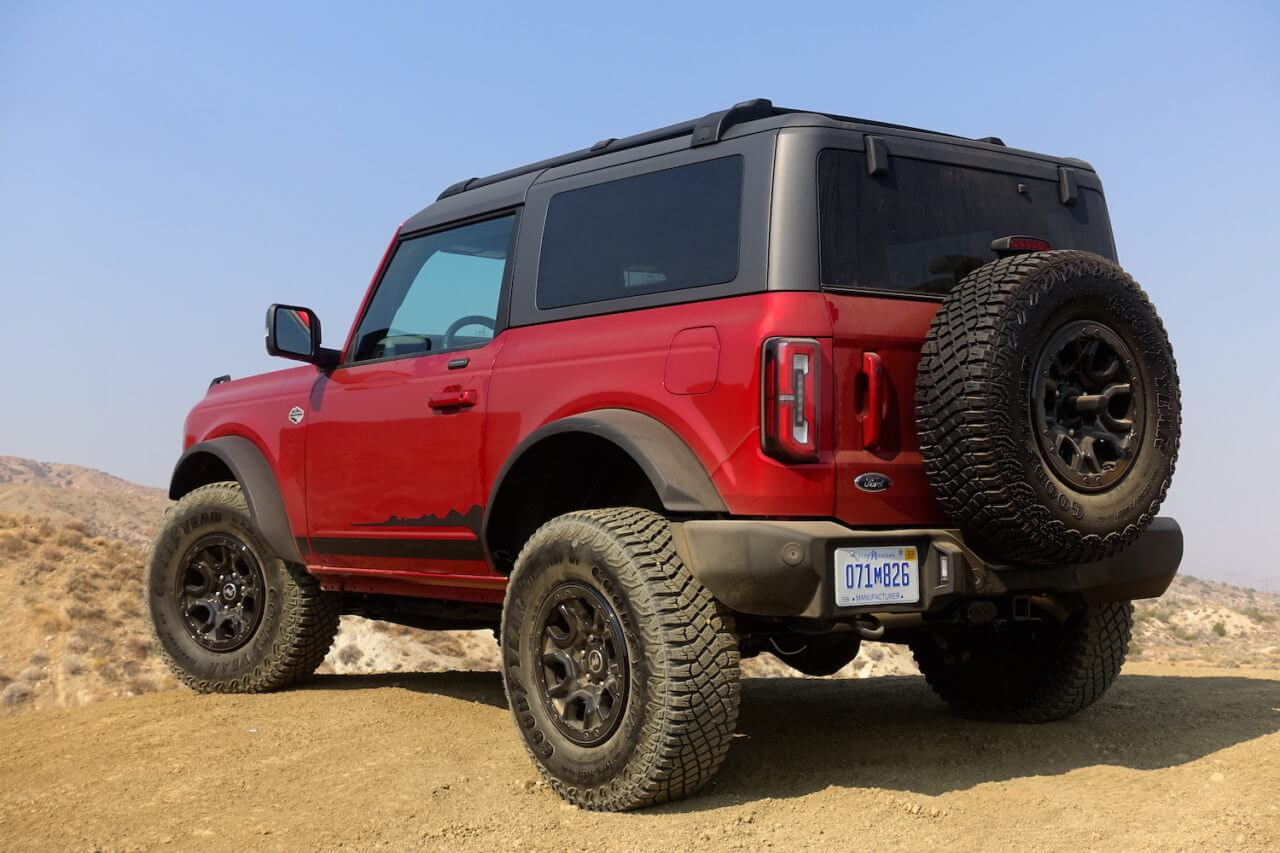
Our $55,425 Rapid Red two-door Wildtrak trim includes the Sasquatch package with 35-inch tires, high-clearance flares and taller (HOSS) Bilstein suspension, front and rear locking differentials and 4.70:1 gears. The Wildtrak comes standard with the 2.7-liter EcoBoost V6 paired to Ford’s 10-speed automatic, G.O.A.T modes (including Baja mode), and a 4WD system with all-wheel-drive in addition to 2WD, 4WD high range and 4WD low range. There’s a standard black hardtop too, as well as a 12-inch touchscreen on the inside. Ours was optioned with the $2,195 leather seating package and the $3,590 Lux Package that includes B&O audio w/navigation, adaptive cruise control, a wireless phone charging pad and more.
The $44,695 Jeep Wrangler Rubicon was recently purchased by a 4WP employee and came wearing $245 Hellayella paint, the $1,495 three-piece hardtop in black with headliner ($495), all-weather floormats ($165) and finally the $1,500 turbocharged 2.0-liter four-cylinder engine and 8-speed automatic (Package 22R). Though this Wrangler has far fewer options than the Bronco in terms of tech and luxury, the Rubicon package comes standard with 33-inch tires, an electronic swaybar disconnect system, front and rear locking differentials, high-clearance fenders, and a one-inch taller suspension.
The Specs and Hardware
The Ford and Jeep are sized similarly, but once you park them side-by-side, the Bronco is clearly the larger of the two. The Ford’s 100.4 inch wheelbase is 3.6-inches longer than the Wrangler. And the Bronco is a whopping five inches wider. It’s also taller by over an inch and a half. As one might guess, the extra size means extra weight. And although weight specs listed for the Bronco are preliminary, our well-optioned, hardtop Wildtrak weighs almost 800 pounds more than the Wrangler Rubicon. Yes, that’s a big number. However, the Bronco can also carry slightly more payload and ours was rated to handle 1000 pounds vs the Wrangler’s 700 pounds.
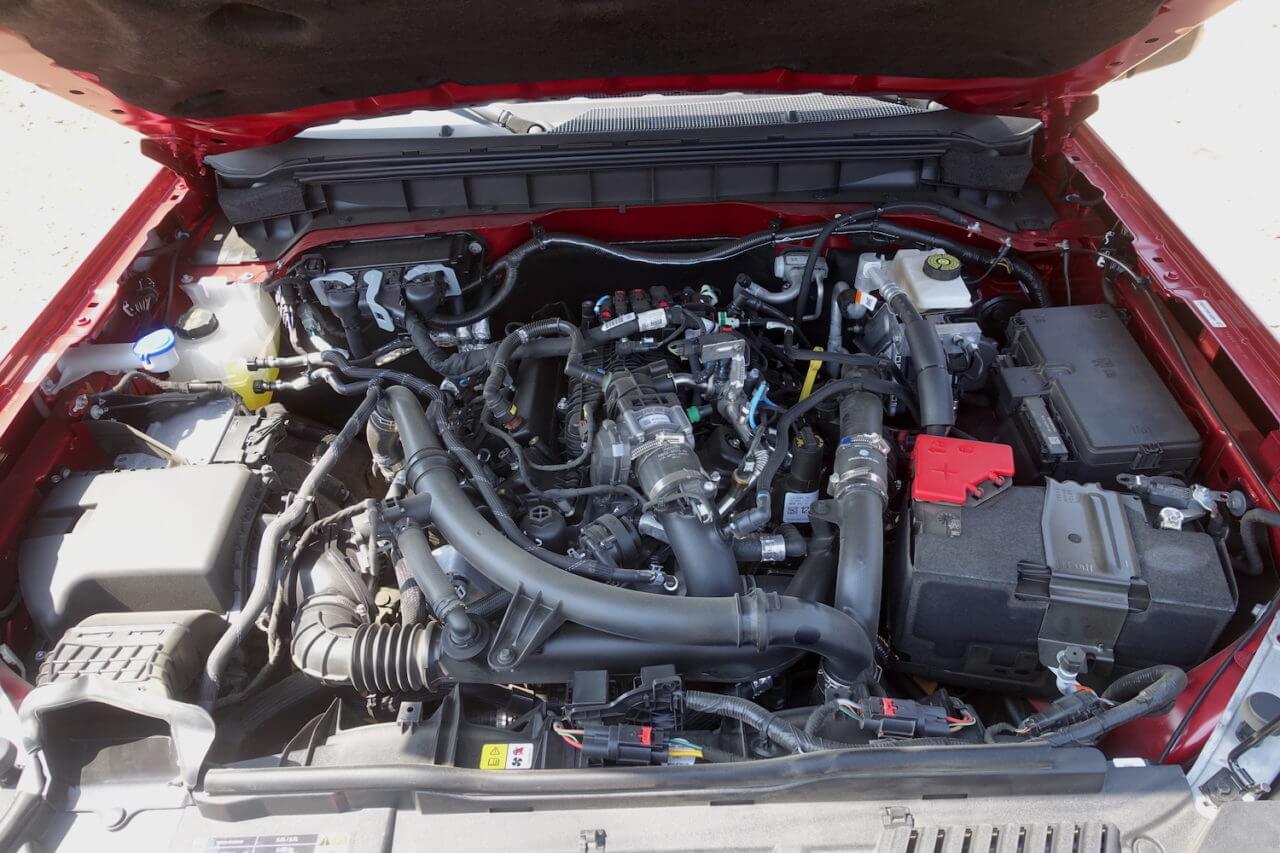
Under the hood, Ford makes the larger 2.7-liter EcoBoost V6 standard on the Wildtrak and it produces 330 hp and 415 lb-ft of torque. It comes hitched solely to the 10-speed automatic. Want a manual? You’ll have to opt for the 2.3L four-cylinder and a lower trim level. One look under the hood and it’s clear Ford could have spent a few bucks on an engine cover. The engine room just doesn’t look “finished”. On a vehicle with as much heritage as the Bronco, why not come up with a special look for the engine bay? Ford does exactly that with the Mustang.
Jeep offers an incredibly wide selection of powertrains for the Wrangler from the new plug-in hybrid 4xe to the rip-snorting 392 and torque-rich diesel. But this Rubicon came with the engine that lines up best with the Bronco’s V6—the 270 hp turbocharged 2.0-liter four-cylinder making 295 lb-ft of torque. No, these numbers aren’t as impressive as the Bronco, but the Jeep weighs so much less it should be an even battle. Jeep dresses the engine with an engine cover and generally the look here is more finished than that of the Bronco.
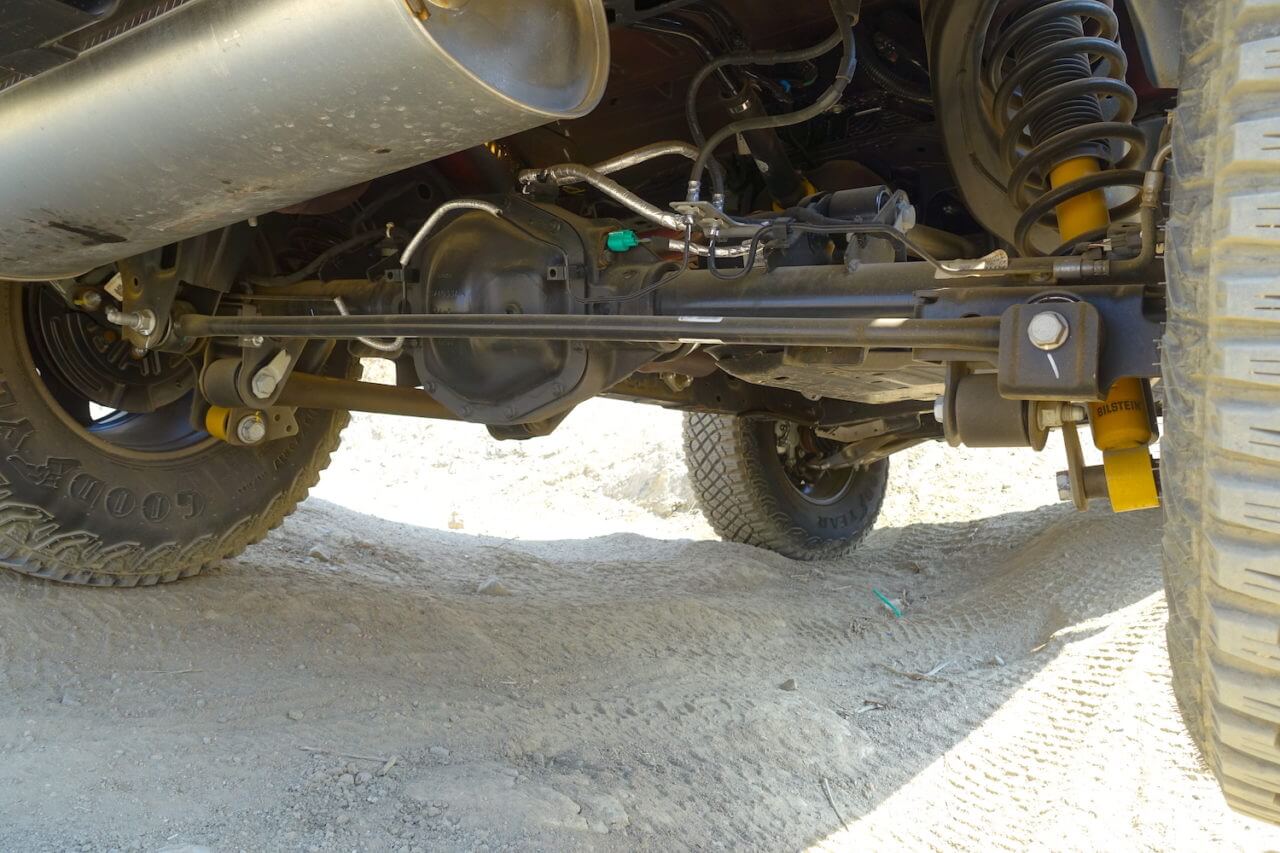
Both vehicles have a fully boxed steel frame. And hanging from the rails are some similar components. The Bronco uses a Dana “44” Advantek 220 rear axle. It’s suspended by coil springs, Bilstein dampers and uses a five-link design. On Broncos with 35-inch tires, Ford specifies a 4.70:1 gearset. And as part of the Sasquatch package, there’s an electronic locking rear differential.
Jeep also uses the Dana “44” Advantek 220 rear axle but fills it with 4.10:1 gears. An electronic locking differential is part of the Rubicon package, and the solid axle also uses coil springs and monotube dampers located by a five-link design.
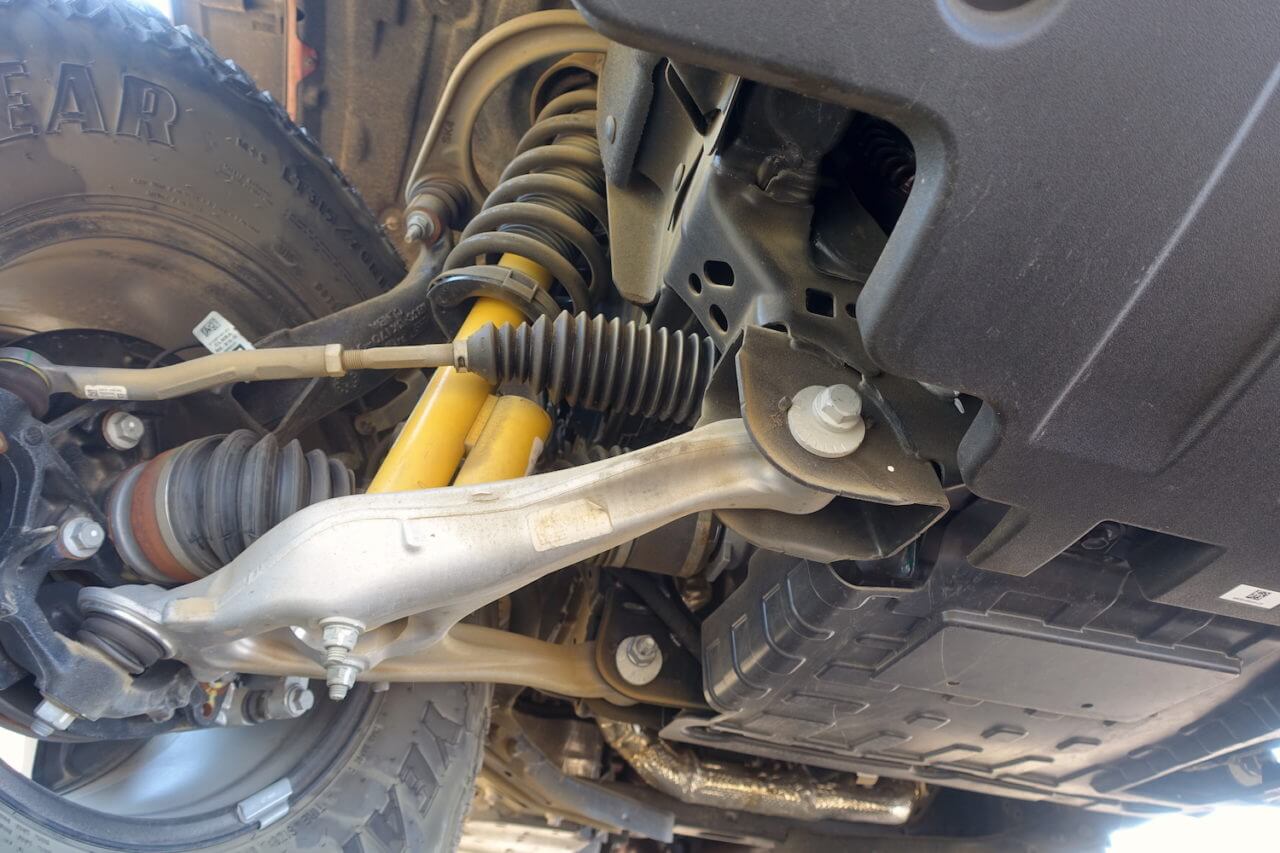
Up front, the Bronco has a Dana Advantek 210 differential with an independent double wishbone suspension. It has an electronic locking front differential and uses coil springs and Bilstein dampers. The Wildtrak doesn’t come standard with skid plates—they are optional. So all the black shielding you see underneath here is merely plastic.
Up front, the Jeep retains a solid axle version of the Dana Advantek 220 with an electronic locker suspended by coil springs and controlled by a five links. As part of the Rubicon package, there’s an electronic swaybar disconnect system.
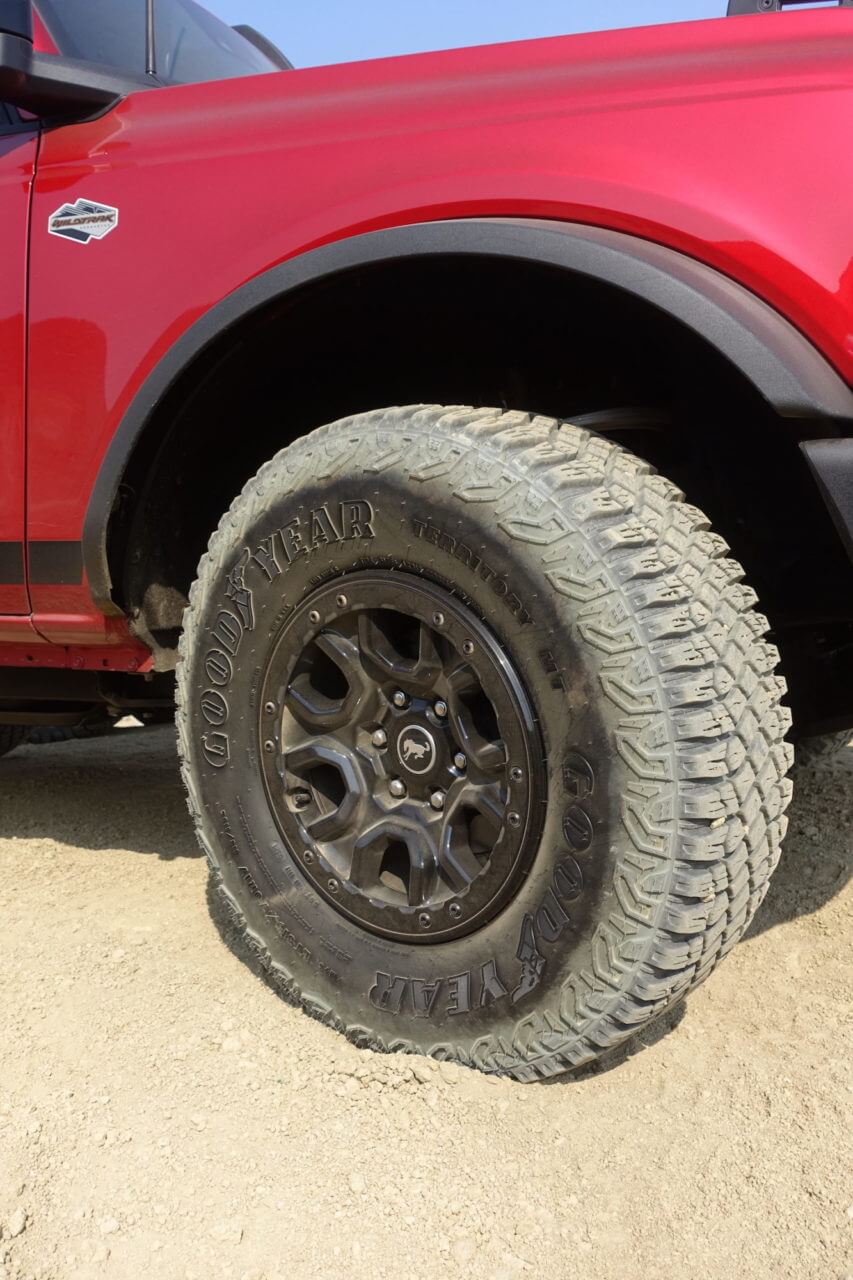
The Bronco’s 315/70R17 (35-inch) Goodyear Territory tires on beadlock-capable 17X8.5-inch wheels provide excellent ground clearance—11.6-inches.
The Wrangler Rubicon’s 285/70R17 BF Goodrich All-terrain KO2s sit on one inch narrower 17-inch wheels and provide 10.8-inches of ground clearance.
On the Street
After spending time in both vehicles, our testers had the impression that the Bronco was much roomier than the Wrangler. One driver even commented that it felt like a fullsize SUV, as he sat in the driver’s seat and took in the space around him. We all agreed that the Bronco would be the better choice for taller drivers too. However, the hard numbers don’t show much of a difference. The Bronco has less than an inch more headroom up front and rear seat legroom is identical between the two. However, in terms of cargo capacity, the Bronco proves it is indeed physically larger inside with over 20 cu-ft more cargo space with the rear seats folded. That’s quite a bit and it could make the Bronco the better choice for longer off-road adventures—or trips to a big box store.
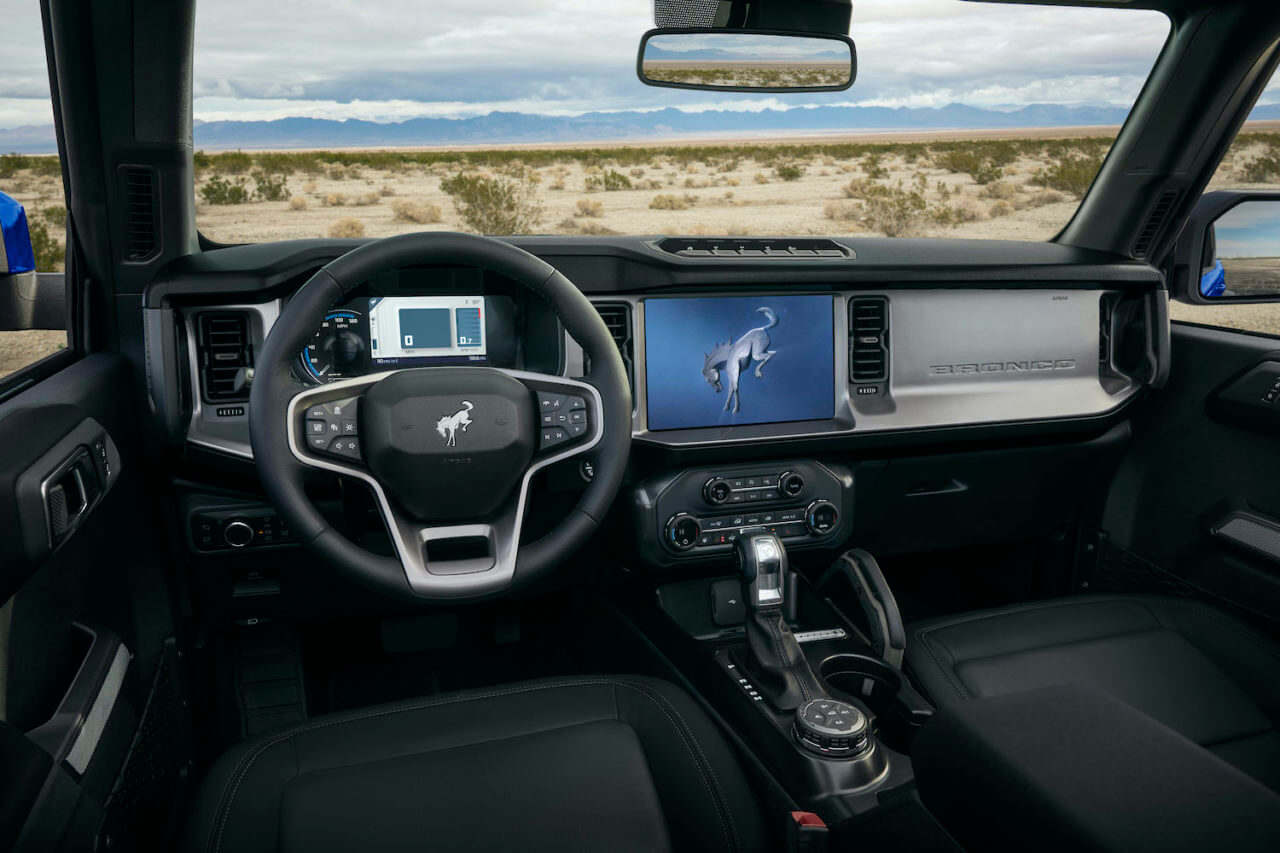
The Bronco is the more refined vehicle of the two. It’s quieter and in terms of the vehicle’s structure, feels more solid. Thanks to that independent front suspension, the Bronco steers with more precision too. The Bronco rides and drives more like a conventional SUV than the specialized trail machine that it is. The Wrangler’s suspension isn’t rougher riding per se, but you do feel more vibration from the road coming up through the wheel and you can hear the chassis creak as it twists over big bumps. Plus, the steering inputs feels less precise.
When it comes to power and torque, the Bronco comes up on top—but those numbers translate into barely quicker acceleration times. Still, both vehicles are very quick. Our friends at Car and Driver tested similar versions of the Jeep and Ford to 60 mph and found the Wrangler to hit 60 mph in 6.5 seconds and the Bronco to arrive in 6.3 seconds. That’s virtually a tie. The Bronco has more power and torque, but that advantage is likely offset by the added weight. In our own informal drag race, the Wildtrak was able to pull ahead of the Rubicon by about a car length in a sprint to 70 mph. The difference around town is that the Bronco has a bit more low-end torque. Plus, Ford offers both “Sport” and “Eco” modes as well as a “Slippery” mode for wet weather to tailor the throttle, transfer case and transmission performance for the road conditions. The Wrangler is fleet-footed but you do notice that the turbo lags a bit more when building torque. And Jeep doesn’t offer specific modes suited to the terrain or road condition.
When it comes to fuel economy, the Wrangler pulls way ahead with an EPA rating of 22 mpg city and 24 mpg highway. The Bronco is rated at 17 mpg for both city and highway.
Low Range Crawling
Out in the desert and locked in low range, both of these trail champs were definitely in their element. The Wrangler is easier to drive out in the dirt here simply because the outward visibility is better. The Jeep’s low hood and front fenders provide a great view of the trail ahead. And you sit physically lower in the Jeep too, which combined with its tighter wheelbase makes it feel a bit more nimble. All of this makes the driver feel more connected to both the Jeep and the trail.
The Bronco is taller and the large flat hood with fender peaks make placing the tires more challenging. The Bronco just feels bigger. However, the truck’s Trail Turn Assist feature is handy for tight spots and will essentially drag the brake of a rear tire to help the big pony carve a tighter circle. Both vehicles are geared well for the trail but the Wrangler’s crawl ratio of 77.2:1 has the edge over the Ford’s 67.8:1 ratio.
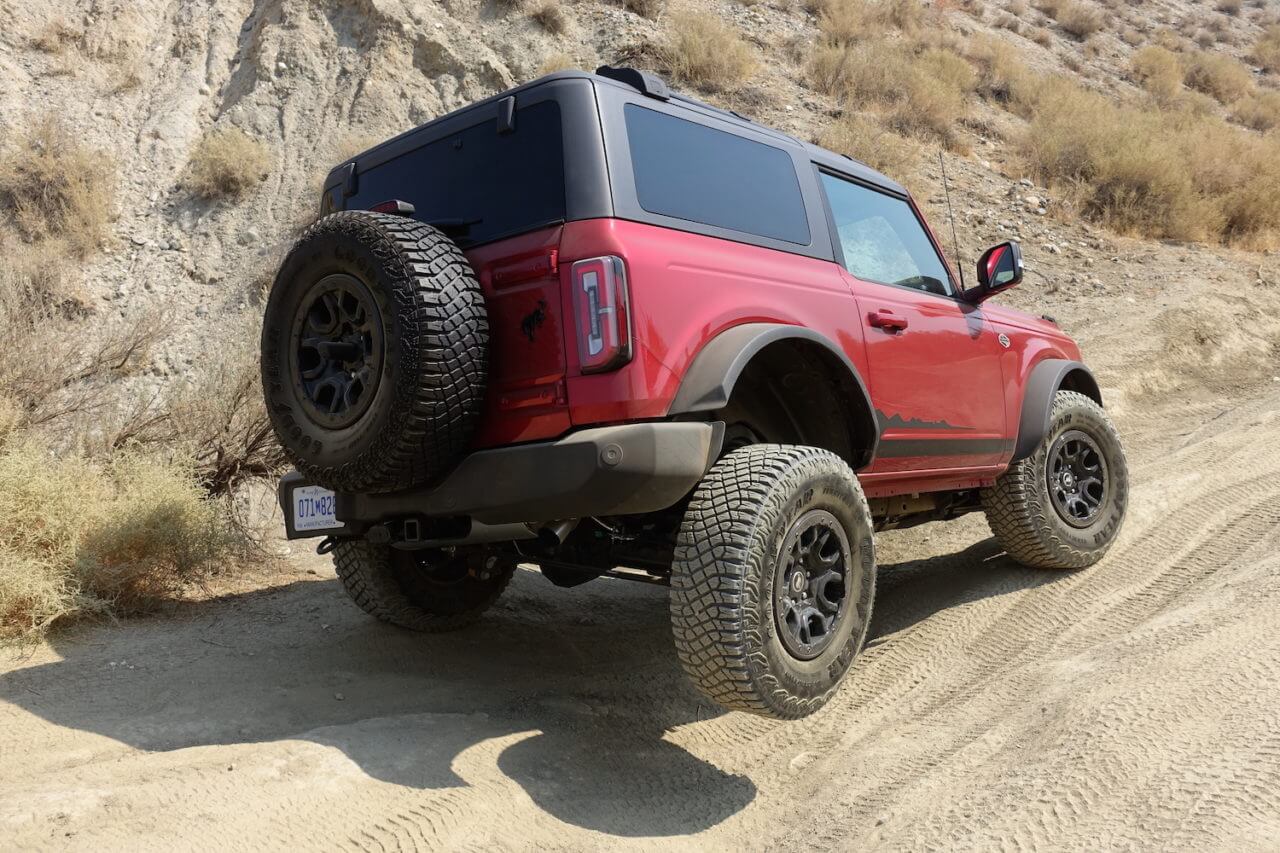
But the suspension performance is where the Jeep pulls just ahead of the Bronco in slow speed crawling. The Jeep’s solid front axle suspension simply provides more articulation. And that’s whether the front swaybar is disconnected or not. When the deep ravines and moguls maxed out the articulation of both vehicles, the Jeep was the one that most easily pulled through without the aid of the locking differentials. Not only did the Jeep keep the tires on the ground better, but the traction control arrested tires slippage much quicker. It just helps the driver handle slow-speed off-roading with more elegance and finesse.
The Ford’s increased ground clearance over the Jeep was great to have as was the slightly better breakover angle—we never scraped its belly. But the Bronco’s suspension was the limiting factor in terms of trail performance. The Wildtrak often lifted the tires in the air and generally relied on the rear suspension to do most of the work. It felt less stable and far less at home in areas that demanded serious articulation. And once the tires lost grip, Ford’s traction control system didn’t clamp down on the tires quickly enough. The most graceful way to ‘wheel your way through slow-speed terrain in the Bronco is to always lock the rear axle or both axles.
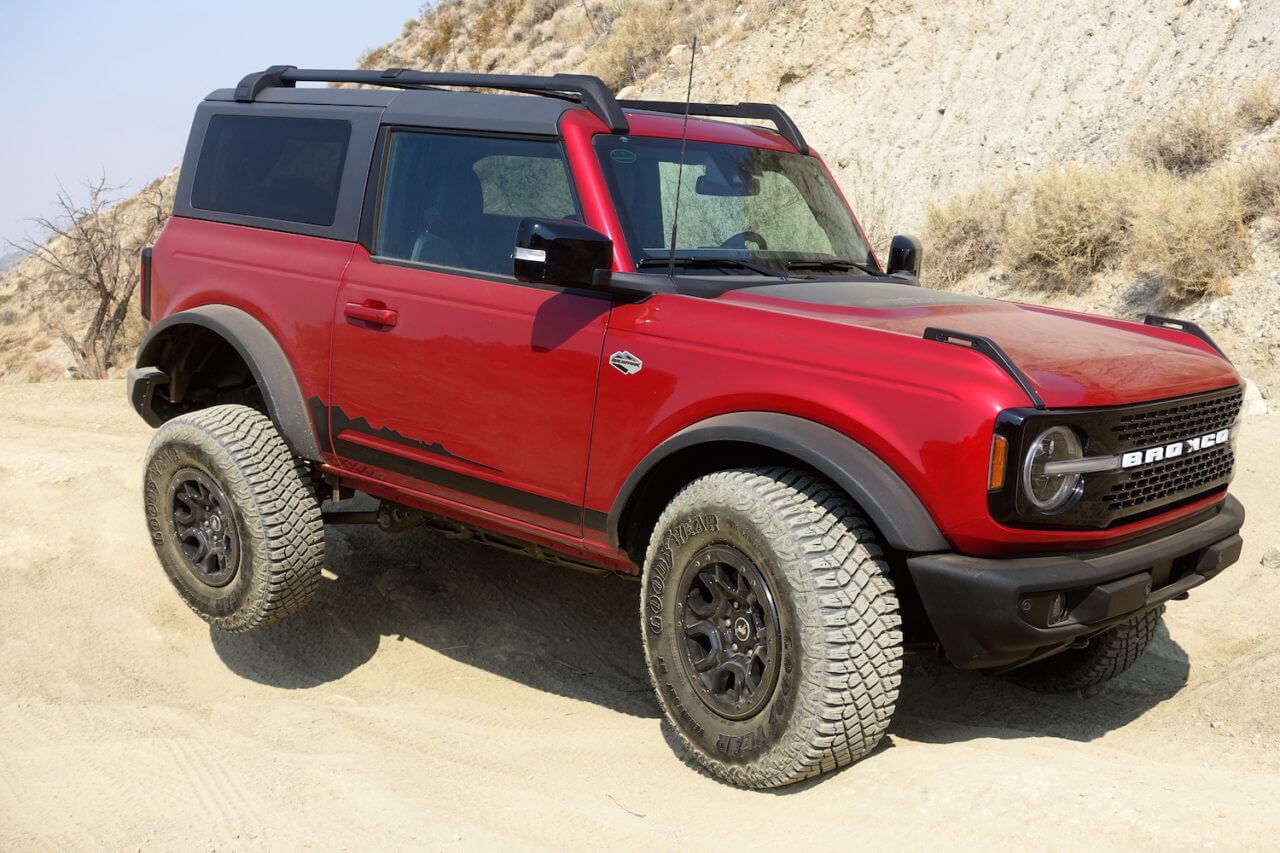
Would the situation have been improved if the Wildtrak had the swaybar disconnect system and Rock Crawl mode of the Badlands? Probably. And when we can get our hands on one, we’ll be sure to head back out on the trail for another round. But here’s the thing, Jeep says a Rubicon two-door has a ramp travel index (RTI) of 890 with the swaybar disconnected—and that’s a lot of flex. Even a Badlands two-door with the swaybar disconnected can’t match that. Ford says that model scores an RTI of 700.
Hill Climbing
Our desert test area offers some fantastic hill climbs. Some were super easy; others were downright sketchy. But we found one that offered just the right amount of difficulty to challenge both vehicles.
The Rubicon is well-suited for steep and loose dirt climbs. And this one has a series of moguls toward the top that really tested traction. The Jeep easily crawled up the hill and with the swaybar disconnected – flexed its way through the most difficult section with a little sawing of the wheel and a touch of traction control. We never came close to needing the lockers here and the whole experience was smooth, controlled and confidence inspiring. It could have easily handled a tougher climb.

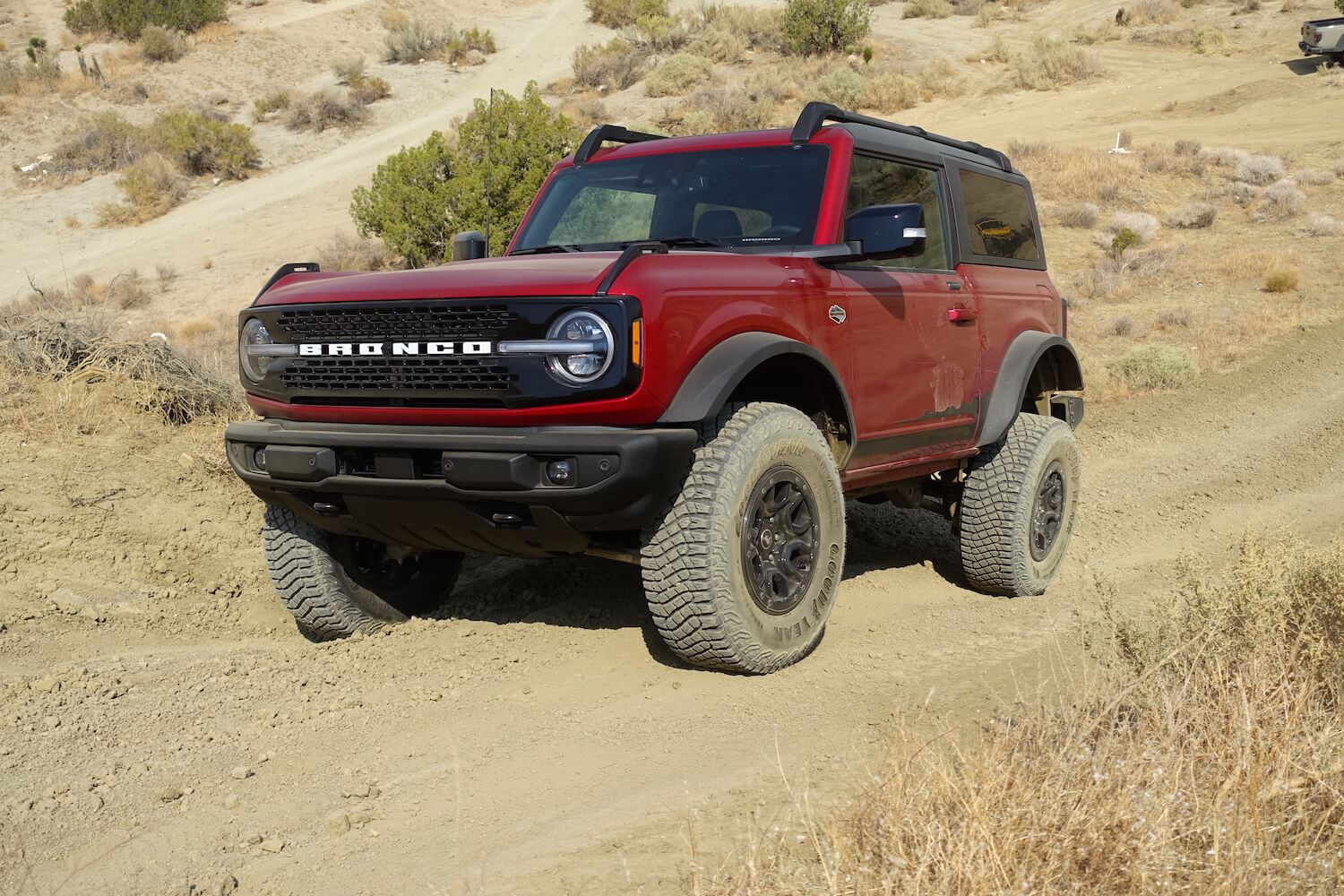
The Bronco had more difficulty here than the Jeep. The Ford crawled most of the way up smoothly but when the front tires dipped into those divots and moguls, it became a little unstable. Then, as the front tires began to lose traction, the driver’s side front wheel began to sky high into the air—it looked and felt a little dicey, if we’re honest. We fed in more throttle, sawed the wheel back and forth and the Bronco made it to the top (see accompanying video). We tried the run again with the rear locker engaged and there was far less drama, although it still struggled in that difficult section. The smoothest attempt was the third, where we drove the hill with both lockers engaged.
Fire Road Fishtails

The fire road for this section of the test was a snaky, bumpy, undulating ribbon of dirt. The one-lane dirt track twists up and around miles of high voltage powerline towers that dot the landscape. The road was a perfect test for both vehicle’s suspensions at higher speeds. And here, the Bronco felt more composed. The suspension did an excellent job soaking up the jolts from bigger rocks. And the steering was very direct, making the truck easy to drive quickly. The potent V6 hits with plenty of torque and power anytime it’s needed. And that’s especially true when you click the G.O.A.T. mode selector over to “Baja”. Downsides? You could definitely feel the heft of the Bronco here. The Jeep was nimbler. Still, the Bronco’s structure felt stiffer and more robust hammering along this road.
The Rubicon’s lighter weight was a clear advantage here. The Jeep was easy and fun to flick through the corners. And the Rubicon’s soft suspension did a good job absorbing the big bumps. However, the Wrangler’s structure felt like it had a bit more twist and quake when we hit a really rough patch. You could feel the vibrations coming up through the steering wheel. And the Rubicon’s steering was less precise, slower to react and had more play in it than the Bronco, too.
The Bottom Line
In this test, it’s really a battle of strengths. The “best” one is really dependent upon the terrain. It also depends upon how you plan to use the vehicle and what attributes are the most valuable. The Bronco is fun, capable and packs all the retro style one could want. This particular model just wasn’t as adept at the low speed, high-articulation crawling or hill climb chores as the Rubicon. Still, it was better to drive over higher speed terrain and it was much more civilized and refined on the tarmac. Plus, the extra cargo capacity and general comfort might make it a great choice for overlanding.
The Wrangler was the clear slow-speed champ. The solid axle suspension flex, gearing and impressive traction control system make the Jeep massively capable for a stock vehicle. It feels purpose-built to elegantly excel at all types of four-wheeling. But on the street and over higher-speed terrain, the Wrangler feels more primitive, less refined and a little compromised. But Wrangler owners are happy to sacrifice some on-road driving dynamics for all that trail prowess.
The good news is that there’s an amazing abundance of aftermarket parts for both vehicles to make them more useful, look tougher and perform much better in the dirt. So, it’s possible to customize a Bronco or Wrangler into the exact type of four-wheeler that best suits your needs.



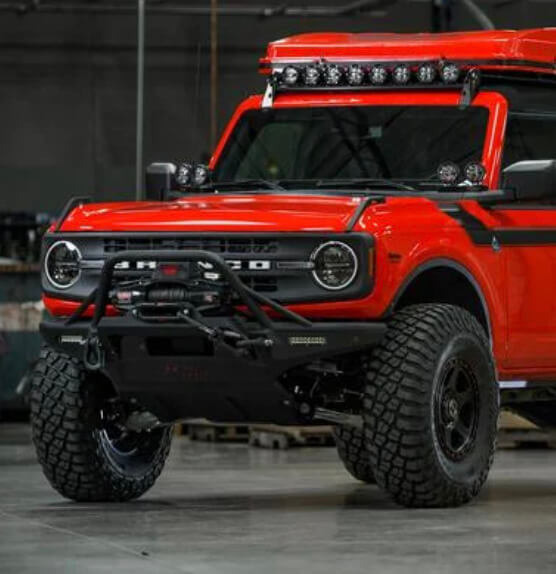

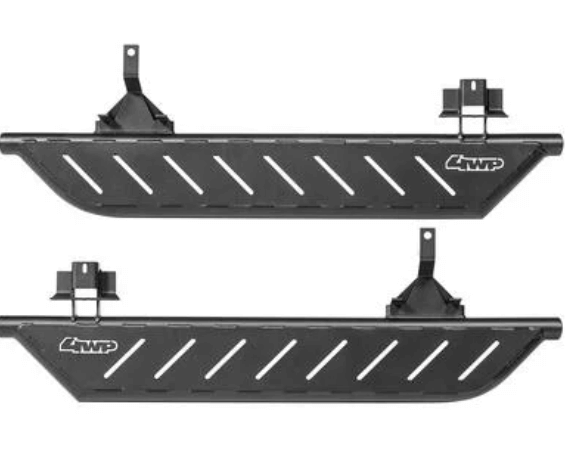
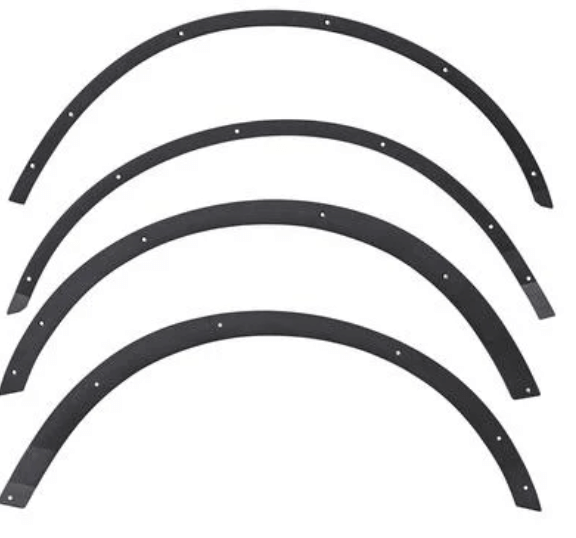


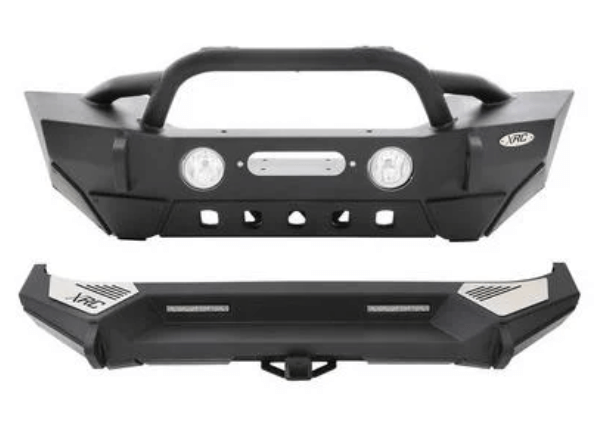
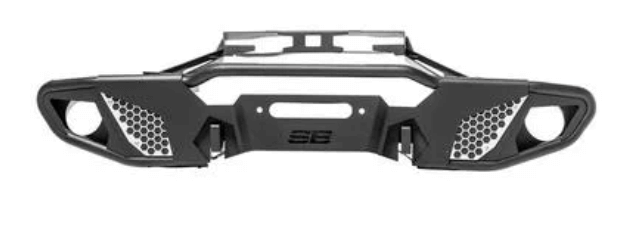

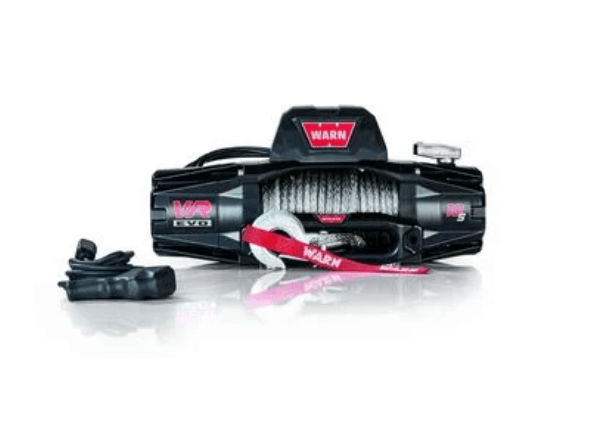

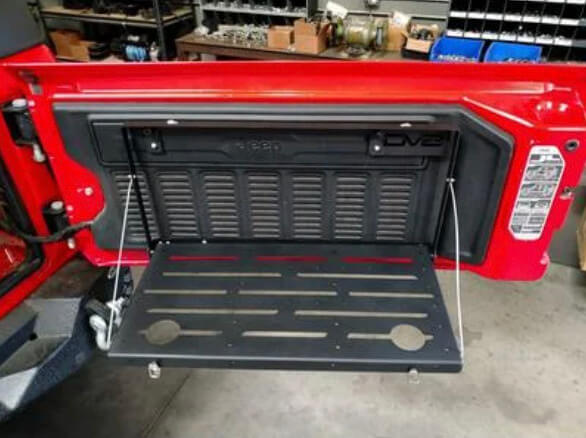
2